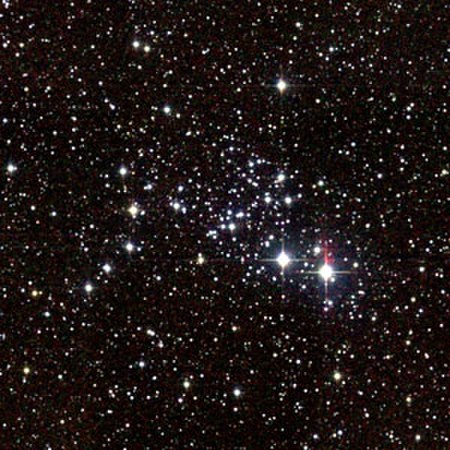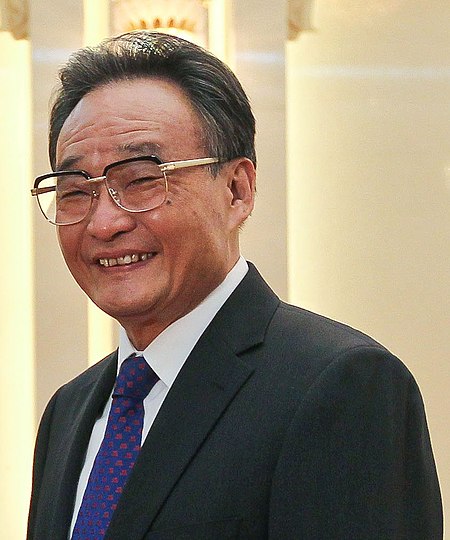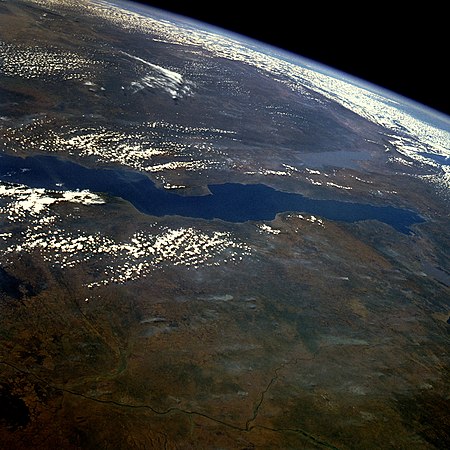Maxakalí language
| |||||||||||||||||||||||||||||||||||||||||||||||||||||||||||||||||||||||||||||||||||||||||
Read other articles:

Greek island in the Ionian Sea For other uses, see Corfu (disambiguation). Corcyra redirects here. For other uses, see Corcyra (disambiguation). CorfuNative name: ΚέρκυραNickname: Το νησί των Φαιάκων (The island of Faiakes)GeographyCoordinates39°36′N 19°52′E / 39.60°N 19.87°E / 39.60; 19.87Area610.9 km2 (235.9 sq mi)Highest elevation906 m (2972 ft)Administration GreeceAdministrative regionIonian IslandsRegi…

Representative of the monarch of Saint Kitts and Nevis Governor-General of Saint Kitts and NevisCoat of arms of Saint Kitts and NevisFlag of the governor-generalIncumbentMarcella Liburdsince 1 February 2023StyleHer ExcellencyResidenceGovernment House, Basseterre[1]AppointerMonarch of Saint Kitts and Nevison the advice of the prime ministerTerm lengthAt His Majesty's pleasureFormation19 September 1983; 40 years ago (1983-09-19)First holderSir Clement ArrindellSalary…

Messier 93, M93, NGC 2447Data pengamatan (J2000.0 epos)KelasI,3,rAsensio rekta07h 44.6mDeklinasi−23° 52′Jarak3.6 kecepatan cahaya (1.1 kpc)Magnitudo tampak (V)6.0Dimensi tampak (V)22.0′Karakteristik fisikRadius10Perkiraan umur100 juta tahun[butuh rujukan]Nama lainNGC 2447Lihat pula: Gugus bola, Daftar gugus bola Messier 93 atau dikenal sebagai M93 atau NGC 2447 ialah adalah sebuah klaster terbuka di konstelasi Puppis. Ditemukan oleh Charles Messier pada tahun 1782. Terletak s…

2010 single by Lil Wayne featuring Nicki MinajKnockoutSingle by Lil Wayne featuring Nicki Minajfrom the album Rebirth ReleasedFebruary 2, 2010Recorded2009Genre Alternative rock pop punk Length4:09Label Young Money Cash Money Universal Motown Songwriter(s) D. Carter O. Maraj K. Crowe E. Ortiz Producer(s)J.U.S.T.I.C.E. LeagueLil Wayne singles chronology Miss Me (2010) Knockout (2010) No Love (2010) Nicki Minaj singles chronology Up Out My Face(2010) Knockout(2010) My Chick Bad(2010) Knocko…

The 16th Politburo Standing Committee, formally the Standing Committee of the Political Bureau of the 16th Central Committee of the Communist Party of China, was elected by the 1st Plenary Session of the 16th Central Committee in 2002, in the aftermath of the 16th National Congress of the Chinese Communist Party (CCP). It was preceded by the CCP's 15th Politburo Standing Committee and was succeeded by the 17th in 2007. Composition Members of the Standing Committee of the Political Bureau of the …

Praz de Lys - SommandOne of the main buildings in the centre of Praz de Lys. With the resort's highest point, Haut Fleury, and the chairlift leading up to it, in the background.Praz de Lys - SommandLocation within AlpsLocationSommandNearest major cityMieussyCoordinates46°08′49″N 6°35′26″E / 46.146956°N 6.590595°E / 46.146956; 6.590595Vertical600 m (2,000 ft)Top elevation2,000 m (6,600 ft)Base elevation1,500 m (4,900 ft)Trails…
2020年夏季奥林匹克运动会波兰代表團波兰国旗IOC編碼POLNOC波蘭奧林匹克委員會網站olimpijski.pl(英文)(波兰文)2020年夏季奥林匹克运动会(東京)2021年7月23日至8月8日(受2019冠状病毒病疫情影响推迟,但仍保留原定名称)運動員206參賽項目24个大项旗手开幕式:帕维尔·科热尼奥夫斯基(游泳)和马娅·沃什乔夫斯卡(自行车)[1]闭幕式:卡罗利娜·纳亚(皮划艇)[2…

مايكروفيجنالشعارمعلومات عامةالنوع مشغل ألعاب فيديو محمولالصانع ميلتون برادليالجيل الجيل الثانيالسعر المبدئي 49٫99 دولار أمريكي (ما يعادل حوالي 309 دولار أمريكي في عام 2020)أهم التواريختاريخ الإصدار نوفمبر 1979 (منذ 44 سنة)توقف الإصدار 1981الوظائفالشاشة دقة 16×16 بكسلوسائط متعددة خر�…

Artikel ini perlu diterjemahkan ke bahasa Indonesia. Artikel ini ditulis atau diterjemahkan secara buruk dari Wikipedia bahasa selain Indonesia. Jika halaman ini ditujukan untuk komunitas berbahasa tersebut, halaman itu harus dikontribusikan ke Wikipedia bahasa tersebut. Lihat daftar bahasa Wikipedia. Artikel yang tidak diterjemahkan dapat dihapus secara cepat sesuai kriteria A2. Jika Anda ingin memeriksa artikel ini, Anda boleh menggunakan mesin penerjemah. Namun ingat, mohon tidak menyalin has…

هذه البوابة رياضية هناك 644 مقالة مرتبطة بالبوابة أهلا بكم في بوابة رماية الرماية هي رياضة تعنى بالتصويب إلى هدف وتشمل سبع أنواع مختلفة وهي: البندقية، رماية الأطباق، اسكيت، أسفل الخط، المسدس الحر، والرماية سريعة الطلقات، ويتم فيها جميعاً استخدام أسلحة وذخائر مختلفة. المزيد &…

Transport museum in Mandello del Lario, ItalyMoto Guzzi MuseumThe museum's Moto Guzzi Tipo Normale of 1921EstablishedJune 2, 2012LocationMandello del Lario, ItalyCoordinates45°54′54″N 9°19′22″E / 45.9151°N 9.322902°E / 45.9151; 9.322902TypeTransport museumCollection size150 motorcycles[1]Websitewww.motoguzzi.com/uk_EN/passion/Museum/ The Moto Guzzi Museum is a transport museum in Mandello del Lario, Italy. The collection includes a number of important …

American political philosopher Harvey MansfieldMansfield in March 2017BornHarvey Claflin Mansfield Jr. (1932-03-21) March 21, 1932 (age 92)New Haven, Connecticut, U.S.NationalityAmericanEducationHarvard University (BA, PhD)OccupationWilliam R. Kenan Jr. Professor of GovernmentNotable workManliness (2006)Children3AwardsNational Humanities MedalGuggenheim FellowshipBradley PrizePhilip Merrill AwardInstitutionsUniversity of California, BerkeleyHarvard UniversityHoover Institution, Stanford Uni…

Multiple unique cultural identities within a larger society This article is about the concept of cultural pluralism. For other uses of the term, see Pluralism (disambiguation). Part of a series onDiscrimination Forms Institutional Structural Statistical Taste-based Attributes Age Caste Class Dialect Disability Genetic Hair texture Height Language Looks Mental disorder Race / Ethnicity Skin color Scientific racism Rank Sex Sexual orientation Species Size Viewpoint Social Arophobia Acepho…

First phase of the Italian Wars (1494-1497) French invasion of Italy redirects here. For the invasions of 1796–1797, see Italian campaigns of the French Revolutionary Wars. For the invasion at the end of World War II, see Second Battle of the Alps. First Italian WarPart of the Italian WarsItaly in 1494Date1494–1498LocationItalyResult Victory for the League of VeniceBelligerents Kingdom of France Swiss mercenaries Duchy of Milan (before 1495) Duchy of Ferrara (officially neutral) 1494:&…

For other uses, see Black Widow (disambiguation). This article needs additional citations for verification. Please help improve this article by adding citations to reliable sources. Unsourced material may be challenged and removed.Find sources: Black Widow video game – news · newspapers · books · scholar · JSTOR (August 2016) (Learn how and when to remove this message) 1982 video gameBlack WidowManual coverDeveloper(s)Atari, Inc.Publisher(s)Atari, In…

Portuguese equestrian José BeltrãoPersonal informationBorn27 November 1905Lisbon, PortugalDied1948 (aged approximately 42)Lisbon, PortugalSportSportEquestrianismEventShow jumping Medal record Representing Portugal 1936 Berlin Team jumping José Gil de Gouveia Beltrão (27 November 1905 – 1948) was a Portuguese horse rider. At the 1936 Olympics he and his horse Biscuit won a team bronze medal in show jumping after finishing sixth individually.[1] References ^ José Beltrão. Spo…

مايكل باور معلومات شخصية الميلاد 16 أبريل 1969 (العمر 55 سنة)إنسبروك الطول 1.81 م (5 قدم 11 بوصة) مركز اللعب لاعب وسط الجنسية النمسا سنوات فريق م. (هـ.) 1989–1996 تيرول إنسبروك 233 (18) 1997 أوراوا رد دايموندز 2 (0) 1997–2002 تيرول إنسبروك 139 (23) 2002–2003 هامبورغ 10 (0) 2003–2007 أوسكو باشينغ 1…

This article relies largely or entirely on a single source. Relevant discussion may be found on the talk page. Please help improve this article by introducing citations to additional sources.Find sources: Badminton at the 2023 SEA Games – Individual event – news · newspapers · books · scholar · JSTOR (August 2023) Event at 2023 SEA Games Main article: Badminton at the 2023 SEA Games Badminton tournamentBadminton at the 2023 SEA Games – Individual even…

Estonian footballer Henri Anier Anier playing for Lee Man in 2023Personal informationDate of birth (1990-12-17) 17 December 1990 (age 33)Place of birth Tallinn, EstoniaHeight 1.82 m (6 ft 0 in)Position(s) StrikerTeam informationCurrent team Lee ManNumber 9Youth career1997–2007 Flora2009–2010 → Sampdoria (loan)Senior career*Years Team Apps (Gls)2008–2009 Flora II 8 (7)2008–2011 Flora 86 (52)2007 → Warrior (loan) 24 (13)2012 Viking 2 6 (4)2012–2014 Viking 16 (0)20…

Nelayan di atas danau Tanganyika Danau Tanganyika adalah danau yang luas di Afrika tengah (3° 20' to 8° 48' LS dan 29° 5' to 31° 15' BT). Danau ini diperkirakan merupakan danau kedua terdalam di dunia setelah Danau Baikal di Siberia, Rusia. Beberapa pulau penting yang ada di Danau Tanganyika adalah Pulau Kumbula, Kibishie, Kavala, Milima, Mutondwe, dan Mamba-Kayenda.[1] Sejarah Danau ini pertama kali ditemukan oleh pengelana dari Eropa pada tahun 1858 (Richard Burton dan John Speke) …